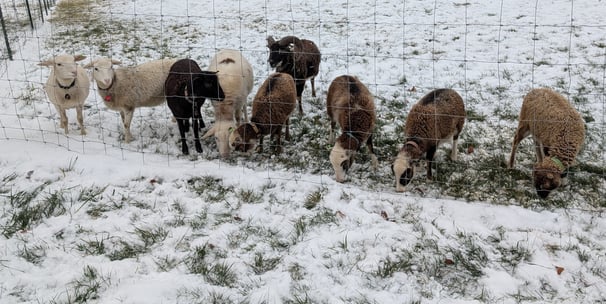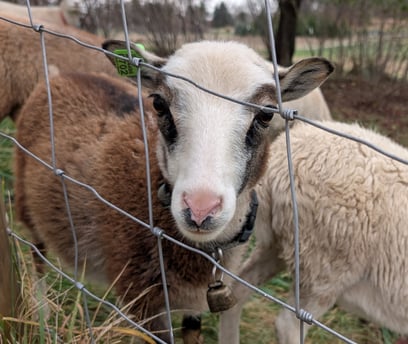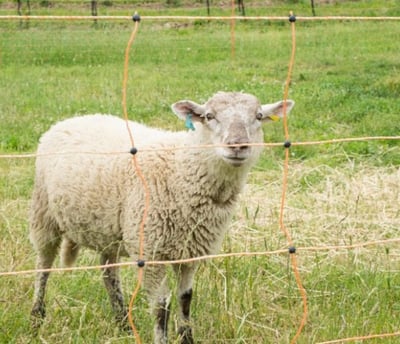Sheep Parasite Management: An Integrated Approach
Parasite management is one of the most significant challenges facing sheep producers today. Internal and external parasites can cause weight loss, poor growth, anemia, diarrhea, decreased production, and even death. Furthermore, the widespread issue of dewormer resistance means that simply treating sheep with medication is no longer a sustainable or effective long-term strategy.
A successful parasite management plan requires an Integrated Pest Management (IPM) approach, combining multiple strategies to keep parasite loads low and preserve the effectiveness of available treatments. This guide will focus primarily on internal parasites (worms), which are often the biggest concern, especially in a climate like Michigan's.


Know Your Enemy: Common Sheep Parasites
Internal Parasites (Worms & Protozoa):
Haemonchus contortus (Barber Pole Worm): The most dangerous. It feeds on blood, causing anemia (pale gums/eyelids), weakness, "bottle jaw," and death. It thrives in warm, wet conditions.
Teladorsagia & Trichostrongylus (Scour Worms): Damage the stomach and intestines, leading to weight loss and diarrhea (scours).
Nematodirus: Primarily affects young lambs.
Tapeworms: Often visible but usually cause minimal harm.
Coccidia: Protozoa, mainly affecting lambs under stress, causing severe diarrhea.
External Parasites: Keds, lice, mites, nose bots, and flies can cause irritation and health issues.
The Cornerstone: Pasture Management
This is your most powerful preventative tool. The goal is to minimize exposure to infective parasite larvae, most of which live in the bottom 2-3 inches of pasture.
Rotational Grazing: Essential for control. Moving sheep regularly through multiple paddocks:
Breaks the Life Cycle: Long rest periods (ideally 30-70+ days, depending on weather) reduce pasture contamination.
Provides "Cleaner" Forage: Sheep graze taller, less-contaminated grass.
Avoid Overgrazing: Keep sheep from grazing lower than 4 inches.
Smart Grazing: Graze susceptible animals on the cleanest pastures; consider multi-species grazing or making hay to break cycles.
Improve Drainage: Reduce wet areas where larvae survive.


Effective parasite management is an ongoing effort. Combining smart pasture use, vigilant monitoring, and strategic treatment is key to a healthy flock.


Smart Deworming: Combating Resistance
Focus on treating only the animals that truly need it.
FAMACHA© Scoring: (Requires training). Assesses anemia levels via eyelid color, specifically for Barber Pole Worm. It's a key decision-making tool.
The Five Point Check©: A broader assessment: FAMACHA Score, Bottle Jaw, Body Condition Score (BCS), Dag Score (manure on rear), and Coat Condition.
Fecal Egg Counts (FECs): Lab tests on manure show egg shedding levels. Used for monitoring, identifying resistant animals, and testing dewormer effectiveness.
Using Dewormers (Anthelmintics) Wisely
Know Your Drug Classes: Understand the different types of dewormers available.
Dose Correctly: Always weigh sheep for accurate dosing. Under-dosing speeds resistance.
Administer Correctly: Ensure oral drenches go over the back of the tongue.
Refugia: By not treating every animal, you maintain a population of non-resistant worms, diluting resistance genes.
Don't Rotate Blindly: Use an effective drug (proven by FEC testing) until it starts to fail. Consult your vet on the best strategy.
Quarantine New Animals: Isolate, test, and treat new arrivals with effective drugs before introducing them.
Other Important Strategies
Genetics: Select for sheep showing natural parasite resistance and resilience. Cull problematic animals.
Nutrition: Well-nourished sheep handle parasites better. Ensure adequate protein, energy, and minerals.
Coccidia Control: Focus on hygiene, avoiding overcrowding, and using coccidiostats if needed (under vet guidance).
Consult Your Veterinarian
Work with a veterinarian experienced in sheep to develop a parasite management plan tailored to your specific farm and location. They are your best resource for diagnosis, treatment decisions, and resistance management.
